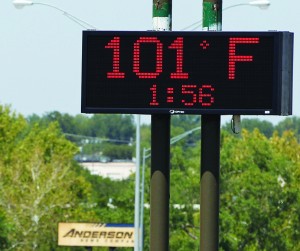Viewpoints Editor
Breaking out shorts and swimsuits this past month coincided with record breaking temperatures for March. The U.S. experienced its hottest March on record, averaging 8.6 degrees higher than the norm from data collected since 1895.
Despite an April which has flirted with snowfall and crisp breezes, the results follow a warming trend that began with a winter six degrees Fahrenheit above the national average. According to the National Oceanic & Atmospheric Administration (NOAA), the anomaly impacted the Great Lakes region the most on March 12-23, with temperatures in the troposphere north of Ohio, including areas in Michigan, Wisconsin and Canada exceeding 15 degrees Celsius higher than expectations. Every state in the union experienced at least one day with a record-breaking high.
Scientists at NOAA constructed projections to determine the warming of the U.S. on an order of .5 to 1 degree Celsius. The March heatwave’s relationship to climate change has yet to be determined, particularly in Ohio and surrounding states. An evolving government report on NOAA’s website rationalized, “the signal of climate change in March temperatures over the Midwest/Ohio Valley region is likely not yet detectable because the standard variability of daily March surface temperatures over the Midwest/Ohio Valley is at least six degrees Celsius, and that the standard variability of monthly-averaged March temperatures is at least two degrees Celsius, both appreciably larger than the estimate signal.”
Scientists at NOAA acknowledge that this heat wave meant more than evidence of global warming, claiming an unnatural La Niña and strong winds from the south, including the Gulf of Mexico, could be the cause. Washington Post editorialist and Princeton Professor William Harper, in a column written March 27, claims “almost nothing” has changed in global temperatures in the last 10 years, and furthermore, “The lack of any statistically significant warming for over a decade has made it more difficult for the United Nations Intergovernmental Panel on Climate Change and its supporters to demonize the atmospheric gas CO2 which is released when fossil fuels are burned.”
This March follows the nation’s second hottest summer on record and the fourth warmest winter. While debates continue to heat up concerning the impact of humans on global temperatures, the College can attest to improving its CO2 output despite dependency on coal.
As of press time, the College’s solar roof above the Scot Center has saved 121 tons of CO2 and generated 168,625 kilowatt hours of electricity since inception.

